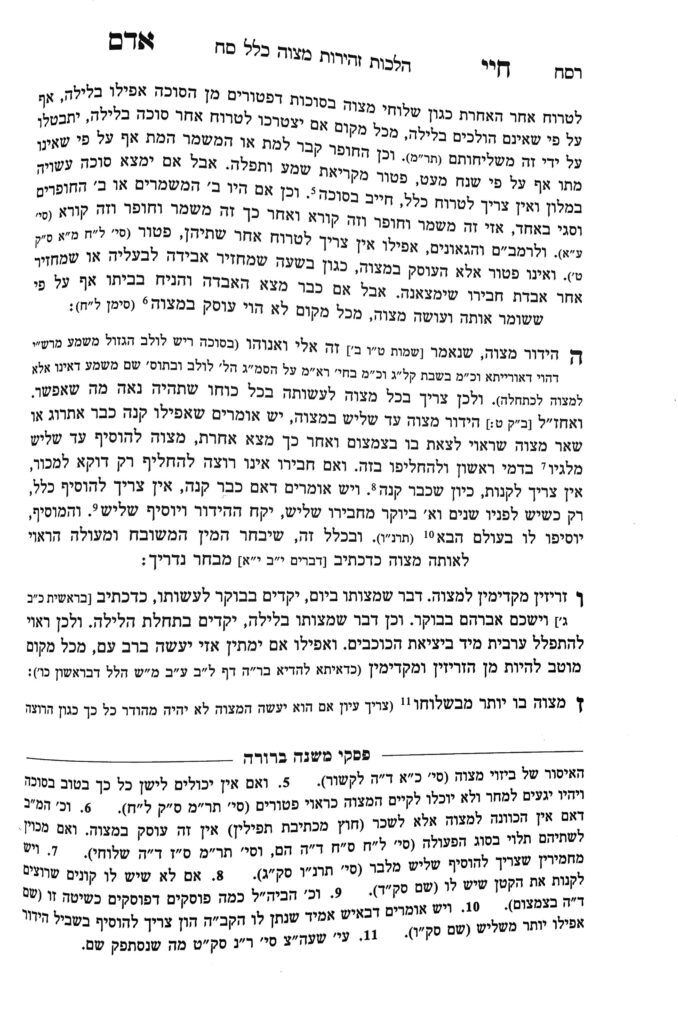We are continuing in siman 7, which discusses the concept of mitzvah bo yoser m’shlucho. We will discuss some points raised by the sefer Nasiach Bechukecha.
We have a rule in the Torah that shlucho shel adam kemoso, a shliach has the same halachic status as the person performing a mitzvah themselves. If a shliach has the same status as the person themselves, how do we know that it is preferable that a person perform the mitzvah themselves?
The Gemara does not bring a source. Rashi appears to understand that it is a sevara. Rashi writes that a person doing a mitzvah themselves physically involves their body, so one is more directly involved in the mitzvah.
Nasiach Bechukecha brings a possible source. We have learned (shiur 1402) that the concept of zrizin makdimin is learned from Avraham Avinu, who, in preparation for Akeidas Yitzchak, rose early to prepare for the mitzvah. The pasuk continues, and says vayachavosh es chamoro, that Avraham himself saddled his donkey. Rashi points out that he did it himself, rather than have others prepare it. Nasiach Bechukecha suggests that the same way the beginning of the pasuk teaches us the concept of zrizin makdimin, the continuation of the pasuk also teaches us something, namely this concept of mitzvah bo yoser m’shlucho.
Nasiach Bechukecha, continues, and writes that if the two concepts are learned from the same pasuk, it is hard to say that one hiddur would take precedence over the other. This thought would answer the question we left off with yesterday, regarding a conflict between mitzvah bo yoser m’shlucho and other forms of hiddur.
He brings from Rav Asher Weiss shlita that the answer to this question may depend on the type of mitzvah in question. If the point of the mitzvah is the action, it may be better to do it oneself. If the point is the outcome, if appointing a shliach will lead to a nicer outcome, it may be preferable to hire someone else. For example, the purpose of the mitzvah of writing a Sefer Torah is for the result of having a Sefer Torah, rather than the action of writing it, so appointing a shliach with more beautiful handwriting would precede the hiddur to mitzva bo yoser m’shlucho.
We learned that the amoraim were makpid to perform a component of the preparations for Shabbos by themselves, rather than leave them to the members of their household. It is clear from the Gemara that they did not do all of the preparations for Shabbos, but did one thing and then left the remainder to a shliach. The Biur Halacha (siman 240) asks why they limited themselves to only one preparation, and answers that they were certainly busy with learning Torah, so they would perform one preparation and return to their learning. However, we know that when it comes to limmud hatorah, one only stops learning to perform a mitzvah which cannot be fulfilled by others. The fact that they allowed the rest of their Shabbos preparations to be done through a shliach demonstrates that all the Shabbos preparations could be fulfilled by others. If so, why were they makpid to do even one preparation?
The Shaar Hatziyun gives two answers. First, he says that the mitzvah of kavod Shabbos is for an individual to demonstrate kavod for shabbos. This mitzvah cannot be expressed through a shliach, because it is on every individual to demonstrate kavod.
The second answer he gives is that maybe kavod shabbos is unique, in that the very mitzvah is to express that one is willing to personally show kavod for Shabbos. In other words, the method through which one demonstrates kavod Shabbos is by personally doing actions for the sake of Shabbos, even if they could have been done by others and even if the person is not technically chayav to perform those actions. Thus, an individual cannot show kavod Shabbos through a shliach, because they completely miss out on the point of kavod Shabbos by doing so
This answer explains why the amoraim would only do one preparation, and leave the rest to their family. Since the mitzvah is to personally demonstrate kavod, once they have demonstrated it with even one preparation, they have fulfilled their obligation, so they went back to their learning and left the rest to others who could fulfill it just as well.
Summary
Mitzvah bo yoser m’shlucho is the concept that a component of hiddur mitzvah is to perform a mitzvah by oneself, rather than through a shliach.
It is not clear what one should do in a conflict between mitzvah bo yoser m’shlucho and other forms of hiddur. One suggestion is that if the purpose of the mitzvah is the action of performing the mitzvah, mitzvah bo yoser m’shlucho would take precedence. If the purpose of the mitzvah is the resulting action, other forms of hiddur would take precedence to mitzvah bo yoser m’shlucho if the result would be a greater hiddur.



